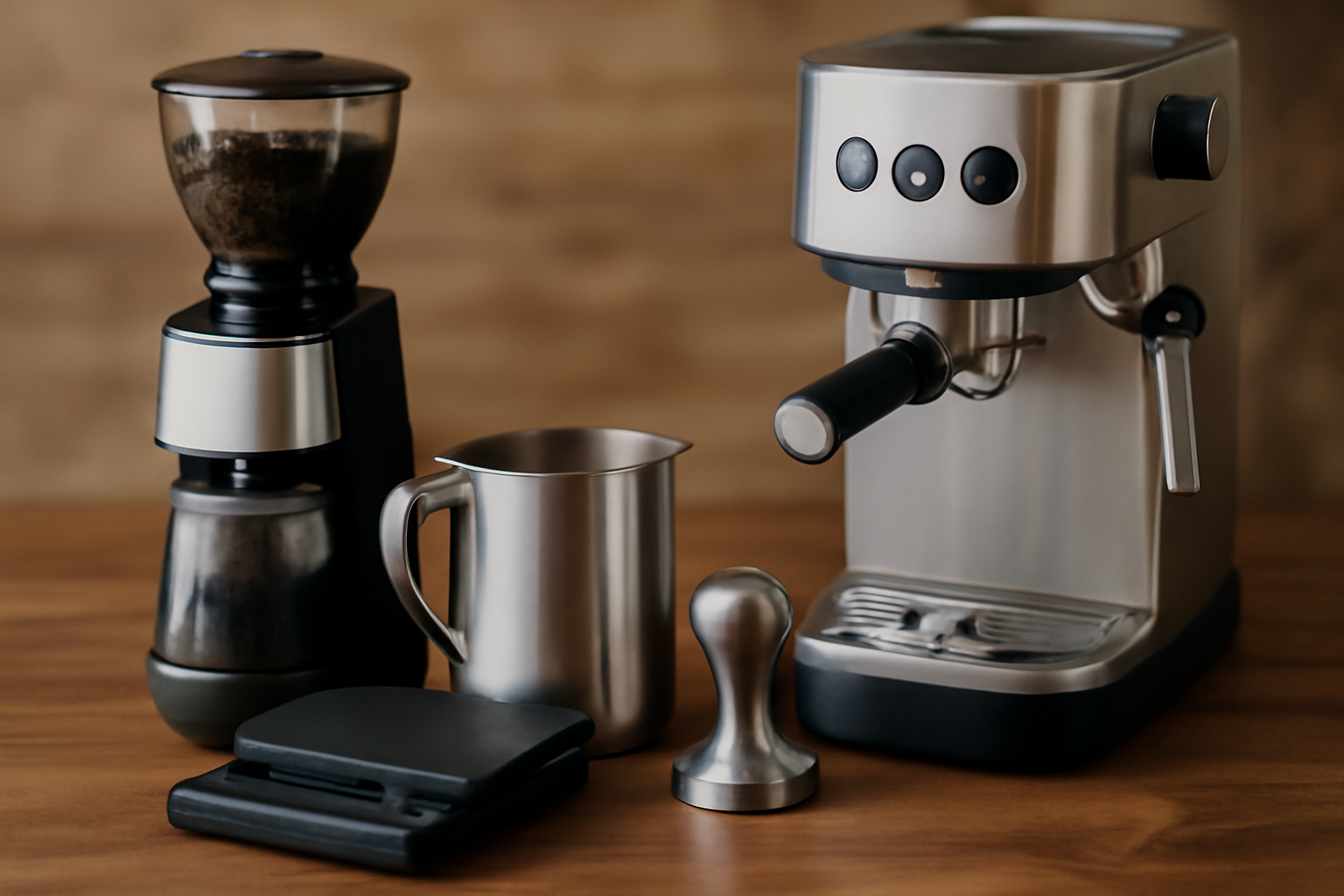Becoming a barista involves more than just learning how to brew a perfect cup of coffee—it’s also about having the right equipment. The quality of your coffee depends heavily on the tools you use, and as a beginner, choosing the right equipment can make all the difference in your coffee-making journey. Whether you’re setting up your home coffee bar or getting started in the coffee industry, having the essential tools at your disposal will give you the foundation to craft high-quality espresso-based drinks and coffee.
In this article, we’ll walk through the essential coffee equipment every beginner barista should have, including grinders, machines, and accessories, and how to select them to improve your coffee game.
1. Espresso Machine: The Heart of a Barista’s Arsenal
An espresso machine is the core piece of equipment for any barista. It’s the machine that creates the rich, concentrated espresso shots that are the foundation of many coffee drinks, such as cappuccinos, lattes, and macchiatos. There are several types of espresso machines, each with different levels of complexity and price points.
Types of Espresso Machines
- Manual Espresso Machines: These machines require more hands-on effort, as you will need to control the water temperature, pressure, and extraction time. Manual machines are perfect for those who enjoy the craft and artistry of espresso making but may require more practice to perfect.
- Semi-Automatic Espresso Machines: These machines are popular among both beginners and professionals. They automate most of the brewing process, but you still need to grind, tamp, and insert the portafilter. Semi-automatic machines offer a balance of control and convenience, making them a good choice for baristas who want to experiment with different brewing techniques.
- Fully Automatic Espresso Machines: These machines take care of the entire brewing process, from grinding to tamping and extraction. They are ideal for beginners who prefer a more straightforward coffee-making experience, though they are often more expensive.
Key Features to Consider
- Pressure: Look for an espresso machine with at least 9 bars of pressure, which is necessary for a proper espresso shot.
- Steam Wand: A steam wand is essential for frothing milk to make drinks like lattes and cappuccinos.
- Temperature Control: A stable temperature is important for extracting the best flavor from your coffee beans. Machines with temperature control will allow you to brew at the ideal range for optimal taste.
2. Coffee Grinder: The Secret to Freshness
One of the most important tools for a barista is a quality coffee grinder. Freshly ground coffee beans are key to a rich, flavorful brew. Grinding your own coffee ensures that you have the freshest grounds possible, which will elevate the overall taste of your espresso.
Types of Coffee Grinders
- Burr Grinders: These grinders are preferred by most coffee enthusiasts and professionals because they produce a consistent grind size. Burr grinders come in two types: flat burr grinders and conical burr grinders. Both types are excellent for espresso, with conical grinders generally being quieter and less messy.
- Blade Grinders: Blade grinders are more affordable but produce an inconsistent grind size, which can lead to uneven extraction. These grinders are fine for casual coffee drinkers but are not ideal for espresso making.
Key Features to Consider
- Grind Size Adjustments: Look for a grinder that allows you to adjust the grind size, as different brewing methods require different grinds (e.g., fine grind for espresso, medium grind for drip coffee).
- Capacity: Consider the amount of coffee you typically brew at once. Some grinders offer larger capacities, while others are more compact.
3. Coffee Scale: Precision is Key
When brewing coffee, precision is essential. A coffee scale is a simple tool that allows you to measure both your coffee grounds and water with accuracy. This is especially important for espresso, where a small change in the coffee-to-water ratio can significantly affect the flavor of your coffee.
Why a Coffee Scale is Essential
- Consistency: A coffee scale ensures that you’re using the exact same ratio of coffee to water every time, which helps you achieve consistent results.
- Control: Using a scale allows you to experiment with different ratios to find the perfect strength and flavor profile for your espresso.
Key Features to Consider
- Accuracy: Choose a scale that measures in small increments (0.1 grams). This will give you the precision you need for espresso brewing.
- Timer: Some scales come with built-in timers, which is helpful for tracking your brew time and ensuring that you’re brewing your coffee for the right amount of time.
4. Milk Frothing Pitcher: The Key to Frothy Milk
A milk frothing pitcher is essential for creating smooth, velvety milk for drinks like lattes, cappuccinos, and macchiatos. These pitchers come in a variety of sizes, and choosing the right one is important for your steaming and frothing needs.
Choosing the Right Milk Frothing Pitcher
- Material: Stainless steel is the best material for a frothing pitcher, as it retains heat well and is easy to clean.
- Size: For beginners, a 12-ounce or 20-ounce pitcher is a good choice, as it allows you to steam the right amount of milk for a standard-sized drink.
- Spout: A frothing pitcher with a narrow spout is essential for pouring latte art. The spout allows for more control when pouring the milk into your espresso.
5. Tamping Tool: The Art of Even Extraction
Tamping is an essential part of the espresso-making process. It involves pressing the coffee grounds evenly into the portafilter to create a uniform surface for extraction. An even tamp ensures that the water flows through the coffee evenly, which leads to a better-tasting espresso shot.
Why a Tamping Tool Matters
- Consistency: A consistent tamp ensures that you extract the full flavor from your coffee grounds, preventing uneven extractions that result in sour or bitter flavors.
- Pressure: Use a tamping tool that allows you to apply about 30 pounds of pressure. This pressure helps to compact the grounds evenly and create a stable surface for extraction.
Key Features to Consider
- Ergonomics: Look for a tamper that feels comfortable in your hand and is easy to use.
- Flat or Convex Base: A flat base is generally preferred for consistent tamping, though some baristas prefer a convex base for a more rounded, evenly packed puck of coffee.
6. Accessories: The Small Essentials for a Complete Setup
While the espresso machine, grinder, and other large tools are the main pieces of equipment, there are several smaller accessories that can improve your coffee-making experience. These include:
- Knock Box: A knock box is used to dispose of used coffee grounds from the portafilter after brewing.
- Portafilter: The portafilter is the handle that holds the coffee grounds. It’s an essential part of the espresso machine and comes in different sizes.
- Cleaning Tools: Regular cleaning is crucial for maintaining your equipment and ensuring a clean, fresh flavor. Look for brushes, cleaning tablets, and other accessories to keep your machine and grinder in top condition.
Conclusion: The Journey to Becoming a Barista Begins with the Right Tools
As a beginner barista, having the right equipment is key to mastering the art of coffee. The tools you use will affect the taste, texture, and quality of your espresso, so it’s important to invest in the essentials. From choosing the right espresso machine and grinder to adding the finishing touches with a milk frothing pitcher and tamper, these tools will help you create the perfect cup of coffee every time.
With practice, patience, and the right equipment, you’ll be well on your way to becoming a skilled barista. So, equip yourself with the essentials, and enjoy the journey of creating delicious coffee drinks from the comfort of your own home.

I’m an economist with 15 years of experience in strategic planning and a lifelong passion for wellness and natural living. As a self-learner, I created Herbalife Balance to share insights on healthy eating, mindful habits, and an active lifestyle. Tennis enthusiast and nature lover, I believe in balance as a path to well-being. Through this blog, I help others live healthier, more conscious lives.

